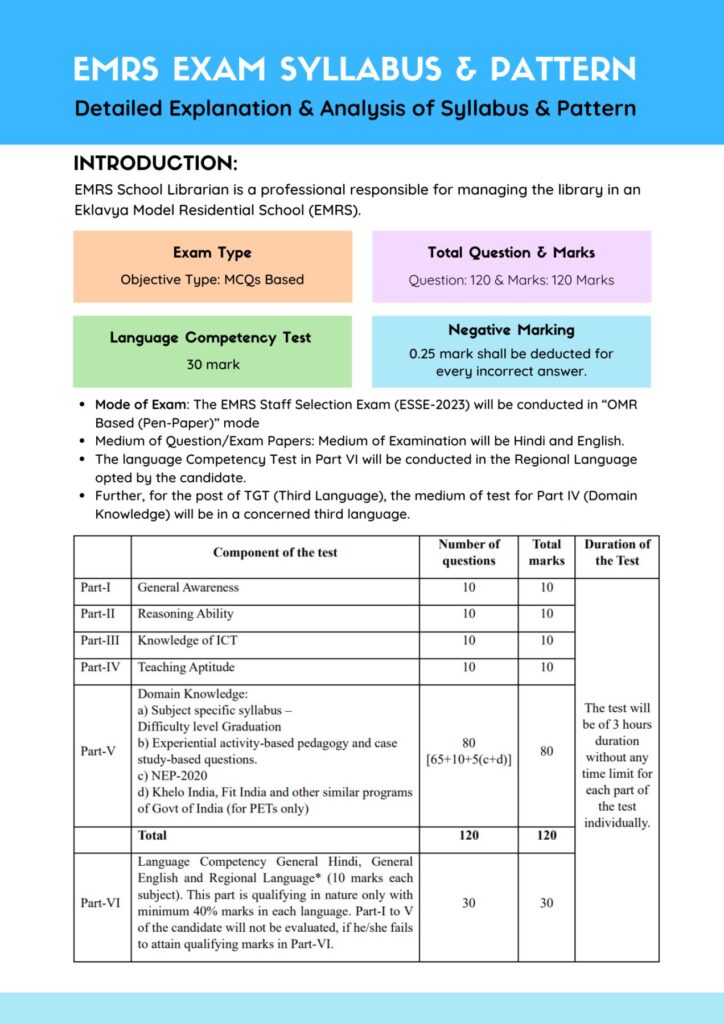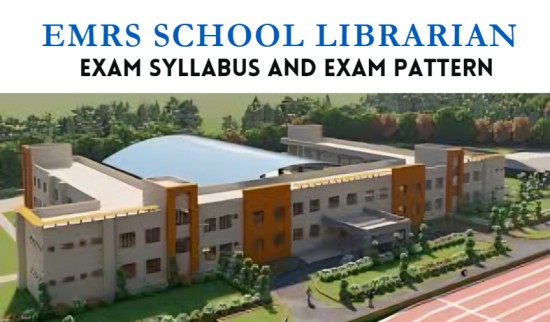EMRS School Librarian Exam Syllabus, Pattern & Previous Year Question Paper with Answer, Download PDF. EMRS School Librarian is a professional responsible for managing the library in an Eklavya Model Residential School (EMRS). EMRS is a Ministry of Tribal Affairs, Government of India to provide quality education to Scheduled Tribes children by establishing residential schools. The librarian’s role in such schools is crucial in supporting the educational needs of the students and teachers of EMRS Schools across India.

EMRS Librarian Exam Pattern
- Mode of Exam: The EMRS Staff Selection Exam (ESSE-2023) will be conducted in “OMR Based (Pen-Paper)” mode
- Choice of Medium of Question/Exam Papers: Medium of Examination will be Hindi and English.
- However, in the case of TGTs, Miscellaneous Category Teachers, and Hostel Warden, the Language Competency Test in Part VI will be conducted in the Regional Language opted by the candidate.
- Further, for the post of TGT (Third Language), the medium of test for Part IV (Domain Knowledge) will be in a concerned third language
- Exam (Objective Type): 120 marks.
- Language Competency Test -30 mark
- Negative Marking- 0.25 mark shall be deducted for every incorrect answer.
EMRS School Librarian Selection Process:
- EMRS Staff Selection Exam (ESSE-2023)
- Document Verification
- Medical Examination.
GENERAL SUBJECTS
- General Awareness: General knowledge and Current affairs with special emphasis in the field of education. • Reasoning Ability Puzzles & Seating arrangement, Data sufficiency, Statement based questions (Verbal. reasoning), Inequality, Blood relations, Sequences and Series, Direction Test, Assertion and Reason, Venn Diagrams.
- Knowledge of ICT: Fundamentals of Computer Systems, Basics of Operating Systems, MS Office, Keyboard Shortcuts and their uses, Important Computer Terms and Abbreviations, Computer Networks, Cyber Security, and the Internet.
- Teaching Aptitude: Teaching-Nature, Characteristics, Objectives, and Basic requirements, Learner’s characteristics, Factors affecting teaching, Methods of Teaching, Teaching Aids and Evaluation Systems.
- Experiential activity-based pedagogy and case study based
- National Education Policy (NEP)- 2020.
- Khelo India, Fit India, and other similar programs (for PET only).
- General Hindi: संधि, समास, विलोम शब्द, पर्यायवाची शब्द, सामान्य अशुद्धियाँ, वाक्यांशों के लिए एक शब्द, मुहाबरे-लोकोक्तियाँ, अपठित गधांश प्रश्न।
- General English: Verb, Tenses, Voice, Subject-Verb Agreement, Articles, Comprehension, Fill in the Blanks, Adverb, Error Correction, Sentence Rearrangement, Unseen Passages, Vocabulary, Antonyms/Synonyms, Grammar, Idioms & Phrases.
EMRS LIBRARIAN SYLLABUS OF LIBRARY & INFORMATION SCIENCE
Part 1: Foundation of Library & Information Science.
Unit.1. Library as a Social Institution
– Social & Historical foundations of Library.
– Different types of libraries- Academic, Public, Special –their distinguishing features and functions.
– Role of U.G.C. for the development of Academic libraries.
– Role of Library in formal and informal education.
Unit.2 Normative Principles of Lib. & Inf. Science
– Five Laws of Library Science.
– Implications of five laws in Lib. & Inf. Science
– Development of Libraries with special reference to India, Baroda Public Library system
– Library cooperation Resource Sharing and Library Networking.
Unit 3. Laws relating to Libraries & Information.
– Library legislation needs and essential features.
– Library legislation in India.
– Maharashtra Public Library Act.
– Press and registration act & Delivery of Books act (Public Library).
– Copyright act, Intellectual Property rights.
Unit.4. Library and Information Profession
– Attribution of profession.
– Librarianship as a profession.
– Professional ethics.
– Professional associations & their role.
– National & International Library Associations- FID, IFLA, LA, ILA, ALA, IASLIC, etc.
– Professional education & research.
Unit.5. Promoters of Library & Information Services
– National level promoters- RRRLF.
– International level promotersUNESCO
Unit 6. Public relations & Extension activities
– Definition
– facets and programs.
– publicity & extension, Outreach activities.
– Library pathfinders (Guides)
– Factors affecting Library development, Literacy, publishing, and Book Trade.
Part II: Knowledge Organization, Information Processing & Retrieval.
Unit. 1. Universe of Knowledge
– Structure and attributes.
– Modes of formation of subjects.
– Different types of subjects.
– Universe of subjects as mapped in different schemes of classification.
Unit. 2 Bibliographic description
– Catalogue purpose, Structure, and types of physical forms including OPAC filling rules.
– Normative Principles of cataloging.
– Overview of principles and practice in document description.
– Current trends in Standardization, description, and exchange.
– Standard codes of cataloging.
Unit. 3. Methods of Knowledge Organization
– General theory of Library Classification.
– Normative principles of classification and their application.
– Species of Library Classification.
– Standard Schemes of Classifications and their Features, CC, DDC, UDC.
– Notation: Need, Functions, Characteristics
– Design and development of schemes of Library Classification, Standard sub-division Index.
– Trends in Library Classification.
Unit.4. Subject Classification
– Principles of Subject Classification.
– Subject heading lists and their feature.
Part III: Information Technology: Basic
Unit.1 Information Technology
– Definition, Need, Scope, and Objectives.
Unit. 2 Computer Basic
– Introduction to Computers
– Overview of Historical Development of Computers.
– Generations of Computers, Classification of Computers.
– Essential Components of the Computer System.
Unit.3 Computer Architecture-Organization of Computer
– Input and Output devices- Keyboard, Scanner, OCR, Printers, Monitor
Unit. 4. Software.
-Operating systems: Single & Multi-User Systems, Basic features of MS-DOS, MS
Windows, Linux, UNIX, Windows NT, etc.
– Programming Languages: Concepts and Tools
– Algorithm & Flowcharting.
Part III: Information Technology: Basic
Unit. 5 MS-Office package
Unit. 6 DBMS Package
– Familiarity with DBASE, FOXPRO, CDS/ISIS, SOUL, MS Access (Basic features) Unit
7. Computer application to library & Information work
– Housekeeping operations Unit 8. Communication Technology
– Communication Technology Basic Concepts
– Networking: Basic Concepts. – Internet
Part IV: Management of Libraries & Information Centres/Institutions
Unit.1 Management
– Concepts, definition, and scope.
– Management styles and approaches.
– Management schools of thought.
– Functions and principles of Scientific Management.
Unit.2 Human Resource Management
– Organizational structure.
– Delegation, Communication, and Participation.
– Job Description and Analysis, Job evaluation.
– Inter-personal relation. – Recruitment procedures.
– Motivation, Group Dynamics.
– Training and Development.
– Disciplines and Grievances.
– Performance Appraisal.
Unit.3. Financial Management
– Resources Mobilization
– Budgeting Techniques and Methods PPBS, Zero Based Budgeting, etc.
– Budgetary Control.
– Cost-effectiveness and Cost Benefit analysis.
– Outsourcing.
Unit. 4 Reporting
– Types of reports, Annual report compilation, Contents, and style.
– Library Statistics etc.
Unit 5 System Analysis and Design
– Library as a system
– Project Management PERT/COM
– Decision Tables.
– Performance evaluation standards, MIS.
– Performance Measurement, reengineering, Time and Motion Study
– SWOT (Strength Weakness Opportunities Threat)
– DFD (Data Flow Diagram)
Unit 6. Total Quality Management (TQM)
– Definition, Concept, Element
– Quality Audit, LIS-related standards.
– Technology Management.
Unit. 7 Library House Keeping Operations.
– Different sections of the Library & Information Center and their functions.
– Collection Development and Management Policies Procedures.
– Book Ordering (Acquisition)
– Technical Processing.
– Serials Control, Circulation Control, Maintenance, etc.
– Stock Verification- Policies and Procedures.
– Evaluation and Weeding.
– Archiving-conservation-Preservation.
– Restoration including Print, Non-Print, and Electronic Materials.
Unit.8 Planning
– Concept, Definition, Need and Purpose, Types.
– Policies and Procedures, MBO
– Building and Space Management in Libraries and Information Centers.
– Library Building, Interior & Exterior, Furniture, Equipment, Standards & Types.
– Risk Management, Contingency Management.
– Planning of related Infrastructure, Library Standards.
Unit 9. Management of change.
– Concept of change.
– Changes in Procedures, Methods, Tools, and Techniques.
– Problems of Incorporating Change.
– Techniques of Managing Change.
Part V: Information Sources & Services
Unit 1. Reference and information sources.
– Documentary Sources of Information, Print, Non-Print including Electronic: Special features, Scope, types
– Nature, Characteristic, Utility, and evaluation of different types of Information sources: Physical formats, Authority, Content, Utility.
– Non-Documentary Information Sources.
– Reference Sources Categories, Primary, Secondary & Tertiary Information Sources. (Encyclopedia, Dictionary, Periodical, Thesis, Books, Yearbook, Patents, Trade literature, standards, Monographs, Reference Books, Year Books, Almanac, Atlas, Abstracting & Indexing periodicals, Bibliographies, Handbooks, etc.)
– Internet as a Source of Information.
Unit.2. Reference Service.
– Concept, Definition, Need, Scope and Trends.
– Reference Interview and Search Techniques.
Unit 3. Information Services and Products
– Information services and Products.
– Information services concepts, Definitions, Needs and trends.
– Need, Techniques and Evaluation of Alerting services (CAS&SDI)
– Bibliographic, Referral, Document Delivery and Translation Services.
Unit.4. Information System and their Services.
– Study of National, International and Commercial Information Systems and ServicesBackground, their Services and Products.
Part VI: Library Users
Unit 1. Techniques of Library and Information Centres Survey.
– Proforma method.
– Interview method.
– Records analysis method.
Unit.2. Information users and their information Needs
– Categories of Information users.
– Information needs definitions and models.
– Information-seeking behaviour.
Unit.3 User Education
– Goals and Objectives level, Techniques and Methods, Evaluation of Users’ Education Programmes.
Unit. 4. User Studies.
– Methods and techniques of User studies.
– Evaluation of User studies.
Unit 5. User Orientation Programmes:
– Conventional and modern Techniques: Study tours, Newsletters, Handbooks, Leaflets, PowerPoint. presentations, Websites, etc.
Thank You!
 Subscribe YouTube Channel
Subscribe YouTube Channel

